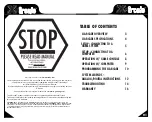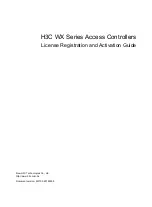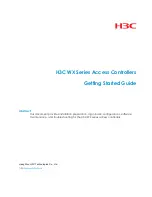
RCF-230TD
2
button. Comfort/Economy is selected via the parameter list.
Economy (Standby):
“Standby” is shown in the display. The heat-
ing and cooling setpoints are freely adjustable. Factory settings:
heating=15°C, cooling=30°C.
Off:
The controller does not heat or cool and the fan stops (unless
mould protection has been selected or the cool-down function for the
electric heater is running, in which case the fan will still run).
Window:
is shown in the display, the controller is off and the fan
stops (unless mould protection has been selected or the cool-down
function for the electric heater is running, in which case the fan will
still run). The window contact is connected to the DI and must be
configured.
Occupancy detection/window contact
Parameter 3 determines if the DI is window contact input or
occupancy detection input. An occupancy detector can be connected
to the DI in order to switch between Comfort and Economy mode. A
window contact can also be connected to the UI1 input.
Setpoint
The setpoint displacement is set using the INCREASE and DE-
CREASE buttons. Parameter 24 determines what is shown in the
display. Refer to the parameter list for details. The basic setpoint is
set via parameter 64.
Fan control
The fan can be controlled via RCF-230TD with the following modes:
Low speed, Medium speed, High speed, Auto. The current fan speed
in the Auto mode depends on the heating or cooling demand and the
settings for each speed.
When using automatic control, ”AUTO” is shown in the display.
The number of fan speed steps can be selected via parameter 30. If
the parameter is set to 1, the first fan speed step will be used for fan
control.
Via parameter 31, it is possible to set the fan to the lowest speed
level when Auto mode is selected. If this parameter is set to 1, the fan
will run in all operating modes except Off and Window (unless mould
protection is active or the cool-down function for the electric heater is
running, in which case the fan will run in these modes as well).
When utilising an electric heater, parameter 1 set to 4, the fan has a
cool-down period of 2 minutes. Fan kickstart can be utilised. The fan
will then run at 100 % for a set time when starting up (0...10 seconds).
Manual control of the fan speed
By pressing the fan button, you change the fan speed according to
the sequence I
à
II
à
III
à
AUTO. When using manual control, ”MAN” is
shown in the display.
If the fan has been configured not to be affected by the heating or cooling
demand, ”AUTO” will not be shown when pressing the fan button.
Blocking of manual fan control
When the fan has been configured not to run via parameter 25, it is pos
-
sible to also prevent it from being controlled manually. Activation takes
place via parameter 66.
Example:
If the fan is configured to run only during cooling demand and
this function has been activated, it will not be controllable during heating
demand.
Indications
The display has the following indications:
HEAT Heating control
COOL Cooling control
The open window symbol is shown if this function has
been configured and a window is open.
OFF The controller does not heat or cool
On/Off button
By pressing the On/Off button, RCF-230TD will switch between Off mode
and Comfort/Economy mode.
Blocking of buttons
The buttons of the controller can be blocked in order to prevent the set-
tings from being changed by unauthorized individuals. It is possible to
either block only some buttons or, if desired, all of them. Activation takes
place via parameter 65.
The INCREASE and DECREASE button combination will always remain
active in order for the configuration menu to be reachable.
Function for control of an electric heater
RCF-230TD has a function for pulse/pause control of an electric heater
in sequence with a water heater, similar to control of a thermal actuator.
When using an electric heater, the fan will continute to run for 2 minutes
after the heater has been switched off in order to cool down the heater.
When using an electric heater, an external unit (e.g. PULSER-ADD or a
solid state relay) is to be connected between RCF-230TD and the battery.
Note:
RCF-230TD does not indicate fan breakdown or overheating of the
heating coil. Therefore, all connections must be made externally. An over-
heating protection or similar can be used to disconnect the supply voltage.
Parameter list
When the controller is in Comfort mode or Window mode, different param
-
eter values can be set in a parameter list.
Hold the INCREASE and DECREASE buttons depressed simultane-
ously for about 5 seconds until the Service symbol is displayed and
then press the INCREASE button twice.
First the display will show parameter 1. Use the INCREASE and
DECREASE buttons to scroll between the parameters and press the
On/Off button to select the desired parameter. The parameter number
will then be replaced by the parameter value. The value can be
changed using the INCREASE and DECREASE buttons. If a button is
held depressed the value will start scrolling, first slowly and then with
increasing speed.
To exit the parameter list and go back to the basic display, press the
INCREASE button until “EXIT” is shown (one step before parameter
1) and press the On/Off button. You can also exit the parameter list by
pressing down the INCREASE and DECREASE buttons simultane-
ously.
Parameters
The following parameters can be changed in the parameter list.
Nº = parameter number
FS = factory setting
NO = normally open
NC = normally closed
Nº
Description
FS
1
Control mode:
2=2-pipe system
3=4-pipe system
4=Electric heater
3
2
Change-over mode:
0=Heating control, 1=Cooling control, 2=Automatic
change-over depending on analogue temperature
sensor or digital input
2
3
Operating mode when activating digital input 1:
0=Economy mode (occupancy detector)
1=Off mode (window contact)
0
4
Mould protection:
0=Not active
1=Active (fan never stops)
0
5
Deadband at Comfort mode. If the deadband is
2 K, the heating setpoint is equal to the setpoint
minus 1 and the cooling setpoint is equal to the
setpoint plus 1.
2 K
6
Heating setpoint when unoccupied
15°C
7
Cooling setpoint when unoccupied
30°C
8
P-band for the room controller
10 K
9
I-time for the room controller
300 s



































